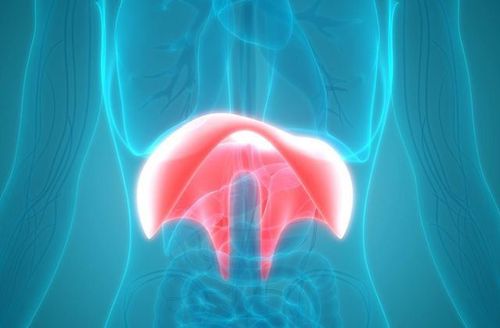This is an automatically translated article.
This article is professionally consulted by: Doctor Nguyen Chi Quang, Obstetrician and Gynecologist, Vinmec Central Park General Hospital. The doctor has many years of experience in the field of obstetrics and gynecology.Partial hysterectomy is the surgical removal of the body of the uterus, leaving the cervix. Partial hysterectomy is indicated in the treatment of diseases: Uterine fibroids, uterine cancer, endometriosis, abnormal uterine bleeding
1. Laparoscopic partial hysterectomy
1.1.Indications Partial hysterectomy is a surgical method to remove the body of the uterus and keep the cervix.
Indications for partial hysterectomy when:
Uterine fibroids, especially when the tumor is large, causing compression to surrounding organs. Ovarian polyps. 1.2.Contraindications Uterine fibroids are too large in size. Patients with acute medical diseases undergoing medical treatment for which no surgical intervention is indicated. Have infectious diseases, blood diseases or other diseases that are contraindicated to surgery. Abdominal distention, diaphragmatic hernia. The operating room is not fully equipped with tools and equipment for surgery. 1.3. Laparoscopic partial hysterectomy technique 1.3.1.Preparation: Patient:
Carefully examine and explain to the patient about the partial hysterectomy. Sign a consent to surgery. To make the patient comfortable before surgery. Doctor:
Professional and experienced. Before performing surgery, make sure the manipulations as well as the equipment are sterile. Tools:
Anesthesia. Anti-shock box and resuscitation drugs for the patient. Prophylactic transfusion and blood replacement. Intubation equipment, ventilator. CO2 gas system, monitor screen. The hysterectomy kit has been sterile. 1.3.2 Partial hysterectomy technique:
Disinfect the abdomen, place a urinary catheter for the patient before surgery.
Conduct general anesthesia, give mechanical ventilation.
Carrying out laparoscopic partial hysterectomy through 7 strokes:
Stage 1: Trocar puncture and CO2 injection into the abdomen.
Make a small incision below the navel about 5-10mm depending on the size of the laparoscope to access the uterus. Raise the abdominal wall to insert the needle, then use a small amount of water on the needle to check if the needle is in the abdomen. Inject CO2 into the abdomen at a rate of 3 liters/min. Set automatic induction if pump pressure 15-20mmHg. A suitable trocar is inserted then the laparoscope is inserted into the abdomen. Check if the trocar is already in the abdomen. Pay attention to poke trocar on both sides of the iliac fossa, near the iliac crest to avoid poking blood vessels. Stage 2: Examine the uterus and surrounding organs in the abdomen.
Observe the uterus, appendages and pelvis. Thorough examination of the stomach and liver and evaluation of uterine lesions. Use a 2-pole knife to burn to stop bleeding before cutting and releasing parts of the uterus. Stage 3: Proceed to release the two sides of the uterus.
Use a 2-pole knife to stop bleeding of the round ligament about 1cm wide, cut between the two burning places. If the ovary is conservatively removed, the bleeding stops and then continues to release the ligament between the uterus and the ovary in the proximal part of the uterus right in the middle of the burning site. If the ovary is not preserved, the ovary is burned to stop bleeding, and the ovarian lumbar ligament is cut. Note that both ovaries are removed only when there is damage or the patient is elderly and does not want to give birth. Stage 4: Dissection of the bladder and uterine artery:
Carry out dissection down to the isthmus of the uterus to clearly expose the uterine artery. Dissect the lower peritoneum, lowering the bladder base. Burn then suture the uterine artery in a horizontal position with the uterine segment corresponding to the isthmus in the absence of pregnancy, taking into account the position of the ureter. Cut 2 pedicles of uterine arteries in turn on both sides. Stage 5: Hysterectomy and apex suture:
Hysterectomy at the level of the waist of the uterus. Then 6: Check the ability to stop bleeding at the cutting sites.
Closely examine the pedicle and cut apex to assess the post-resection condition and the ability to stop bleeding there. Pay attention to check the patient's blood pressure at each time, especially when checking hemostasis. Rinse the abdomen with warm serum prepared previously. Check the vascular peduncles again, no bleeding, clear water is fine. Then 7: Suture the skin:
Remove CO2 and then withdraw the trocar from the anterior iliac fossa. With trocar in the umbilicus with an illuminator, it should be withdrawn last. Carry out suturing the skin according to each anatomical layer from the inside to the outside.
2. Some complications may be encountered during laparoscopic hysterectomy
After laparoscopic hysterectomy, there may be some dangerous complications, but the most common in clinical practice are:
2.1.Bleeding after surgery

2.2. Extraperitoneal hematoma Cause: due to poor hemostasis during surgery. Requires monitoring and medical treatment in advance. Monitor the size of the hematoma for appropriate treatment.
2.3.Injury to the urinary tract After surgery, it may cause damage to the bladder and ureters such as causing inflammation or touching during hysterectomy... Thorough examination and when detecting damage, appoint an appointment. re-surgery to treat those lesions.
2.4.Intra-abdominal peritonitis Indication for re-operation to wash and clean the abdominal cavity, put drainage if necessary. Combination of resuscitation and systemic antibiotics. In addition to the above complications, after surgery, there may also be other phenomena such as adhesion of the cervix to each other or to neighboring organs, which may affect the ability to become pregnant, so it is necessary to be examined carefully before surgery. perform surgery.
Please dial HOTLINE for more information or register for an appointment HERE. Download MyVinmec app to make appointments faster and to manage your bookings easily.














